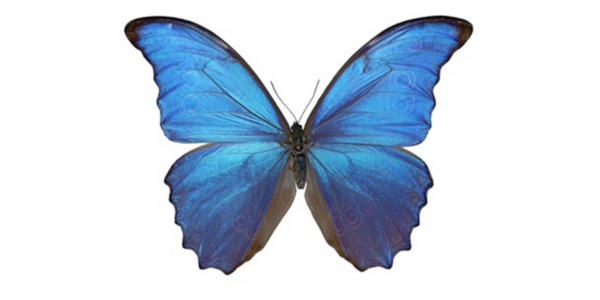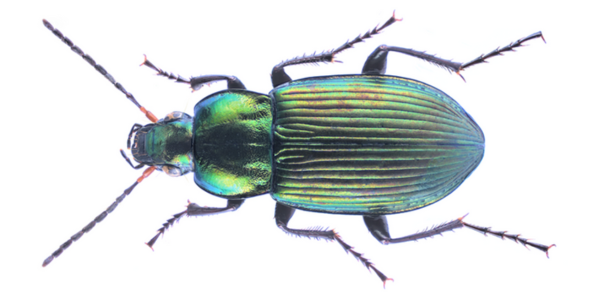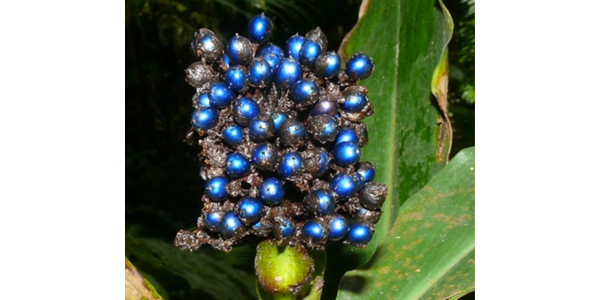It is a familiar thought that the flap of a butterfly’s wing can change the course of history. In the latest in our series of Cambridge innovation articles, I wanted to consider how the wing of the butterfly might – at the very least! – have inspired one start-up to pioneer the future of man-made colour.
But first, it’s worth making a quick visit to a ghost of Cambridge past.
Charles Darwin is most celebrated for his work On the Origin of Species, a seminal articulation of evolution by natural selection, influenced by his famous voyage on HMS Beagle. While this publication came later in his life, his passion for ecology was in early evidence during his undergraduate years in Cambridge.
As a student at Christ’s College, Darwin was a prolific collector of local beetle species. His collection survives today and is on display at the University’s Museum of Zoology.
If you pay a visit, some of the beetles might catch your eye more than others. Members of a small subset of the species seem to shimmer with a vibrant metallic hue, a natural beauty untouched by time.  Image credit: Wikipedia
Image credit: Wikipedia
Silvia Vignolini, a professor in Cambridge’s Yusuf Hamied Department of Chemistry, noticed a similar appearance in a museum specimen of Pollia condensate – the marble berry –, whose fruit has a similarly rich iridescence. 
Image credit: Wikipedia
This effect comes from a phenomenon called structural colouration¹. It derives from the interaction of light with highly-ordered biomolecular micro- or nano-structures at light-exposed surfaces. The interaction transforms the properties of the light to produce the brilliant, iridescent colour observed by the human eye. The same mechanism is responsible for the intensely striking colours in certain other animals and plants², including in the peacock and – you guessed it – butterflies such as Morpho.
Professor Vignolini’s insight would form the basis of technology developed by Sparxell, a company spun-out of her research group. Sparxell aims to replicate the beauty of nature’s structural colour for diverse applications such as cosmetics, textiles, and coatings.
They do so by harnessing cellulose, the particular biomolecule responsible for the colour of the marble berry, and which can be sustainably obtained from abundant plant-based sources. Sparxell’s particular innovation appears to lie in their method for driving the self-assembly of cellulose crystals into the ordered structures which are needed to engender colour.
Having formed the crucial structures, vividly coloured products such as films, liquids, powders, and glitters can be formed. There appears to be some capacity to tailor the final appearance by tuning the interactions between the cellulose crystals.
What I find most compelling about the Sparxell story is the drawing of inspiration from the natural world - butterfly, berry, and beetle! – and a desire to mimic an effect Darwin might have noticed in his Cambridge collection centuries ago.
Perhaps inevitably, learning the lessons from nature, rather than trying to beat it at its own game, reduces the negative impact on that same natural world. Traditional dyes and pigments are often derived from high emissions processes, and frequently contain toxic ingredients. In contrast, Sparxell’s use of renewable plant-derived cellulose makes for a biodegradable product with a more circular life cycle.
It seems that Sparxell have tapped into a wider trend towards sustainable colour. Norwich-based Colorifix has taken inspiration from nature’s colour palette to devise a biological process for producing textile dyes. The methodology here is completely different to that used by Sparxell, but again has improved environmental impact.
Spraxell’s innovation has not gone unnoticed, with the recent completion of a $3.2 million funding round, which included investment from cosmetics giant L’Oréal. This is in addition to a series of high-profile awards over the company’s history, including the Biomimicry Institute’s Ray of Hope Prize, and the Cambridge-based Trinity Bradfield and 21toWatch prizes.
With some neat links to Cambridge past, and some exciting innovations in the present, we are sure that Sparxell will have a glittering future. We look forward to seeing how their work develops.
¹ A subject of interest to another Cambridge figure, Isaac Newton.
² Many of which are also on display at the University of Cambridge Museum of Zoology!



